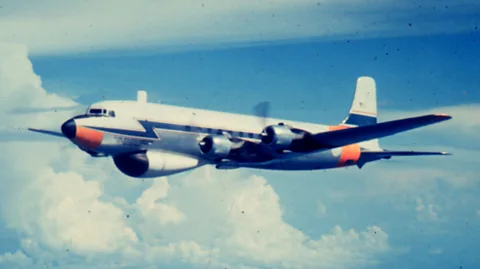What a US mission to control hurricanes taught us about deadly storms
 Office of Noaa Corps Operations
Office of Noaa Corps OperationsAn ambitious project to weaken or divert hurricanes generated decades of suspicion and disagreement. What did we learn – and will it ever be revived?
As a grad student in the 1960s, Joe Golden flew on about a dozen of missions into the "eyewall" of a hurricane, where winds of 160mph (260km/h) battered the sides of his propeller-powered plane. "You could think of it as a ring of thunderstorms that often tower over 40,000ft [12,200m]," says Golden, who photographed hurricanes and gathered data on their development. "And it can also have frequent lightning in it," he adds, matter-of-factly. "So that's another hazard."
Crews on the "hurricane hunting" flights padded their planes' cabin and learned to never ignore orders to strap in when penetrating the wall. But meteorologist Hugh Willoughby recalls thrilling "white-knuckle" flights, including one when life rafts and safety equipment crashed against the ceiling when the plane began falling about 200ft (60m), its engine flaming out. "This is something I dearly loved: get up at 2:00 in the morning, put on my flight suit, lace up my boots," says Willoughby. "Go into the kids' room, pull the covers up over them, kiss them on the forehead, and go out and fly into a raging tempest."
Since the 1940s, pioneers like Willoughby and Golden have been embarking on daring flights into this most intense region of a hurricane to gather data that has expanded scientific knowledge about them and revealed how they develop their lethal force.
But, for a brief window of a few decades, the US Department of Defense and weather services flew missions into the eyewall with an even more ambitious objective: to not only observe these towering storms but to change them. Between 1962 and 1983, under the name Project Stormfury, navy pilots flew missions that released a silver compound into "the belt of maximum winds", just beyond the wall, in the belief that this region was violent but unstable. If so, perhaps it could be disrupted, calming the storm's vicious force.
Six decades after its first flights – and 42 years since it was cancelled – Stormfury veterans Golden and Willoughby a project that gave us vital knowledge that has helped to save lives. But along with this, US attempts to control storms have left behind a controversial legacy that has fueled distrust and conspiracy theories, with some unanswered questions that linger today.
From nuclear weapons to hurricane experiments
Both Golden and Willoughby recall that weather modification projects emerged at a time of enormous optimism following the end of World War Two, when there was a widespread perception that there was no limit to what science could achieve.
In the background was the nuclear bomb, says Kristine Harper, professor of history and sciences at the University of Copenhagen. After the destruction of Hiroshima and Nagasaki, there was expectation that constructive uses of atomic energy would follow, from nuclear power to "atomic gardening" that used radioactive substances to breed new mutant crops.
In 1946, newspaper and radio stations speculated that nuclear weapons might soon safeguard us from acts of God, recounts Harper in her book Make It Rain, an of the US government's attempts at weather control. One New York Times article asked whether atomic energy "by its explosive force" could divert hurricanes away from cities. "You know, maybe we could destroy hurricanes with nuclear bombs">window._taboola = window._taboola || []; _taboola.push({ mode: 'alternating-thumbnails-a', container: 'taboola-below-article', placement: 'Below Article', target_type: 'mix' });
